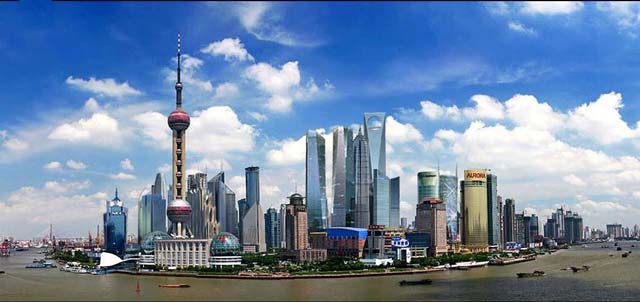
In the first half of 2017, Shanghai’s export growth has shown an increase of 18.7%. Ever since 2012, it’s the first time that Shanghai showed a double-digit growth.
On 20th July, Shanghai Customs announced the export situation for Shanghai exports. According to data collected, Shanghai has accumulated 1.6 trillion yuan worth of imports and exports between January and June in 2017, taking up 11.8% of China’s import and export, ranked third of all provinces in China, just behind Guangdong and Jiangsu.
Shanghai Customs Deputy Director Zheng Jugang commented that although Shanghai’s monthly growth in imports in the first quarter was lagging behind in the nation, the second quarter recorded numbers that were better than the nation. The import in June displayed an increase of 24.6%, which is 1.5% ahead of China’s average.
The increase in export growth was at 20.2%, with a 14.3% increase as compared to the previous month, putting an end to the trailing behind situation during the previous 3 months, and instead exceeded China’s average by 2.9%.
From the structural analysis, Shanghai’s imports are doing better than exports.
The data for the first half of 2017 shows that Shanghai exports are at 626.59 billion yuan, reflecting a 12% growth and contributes to 8.7% of China’s figures. On the other hand, imports are at 926.71 billion yuan, with 23.7% growth and accounting for 15.6% of the total in China.
According to Zheng, the improvement in imports can be attributed to two factors: firstly, the increase in average prices of the import of items. In the first half of the year, the global economy has shown a rosier outlook, thus bringing the prices of commodities up. Of which, iron ore, unwrought copper and copper items, refined oil and coal have an average increase of 49.4%,32.3%, 30.6% and 82.3% respectively, causing a significant increase in growth of import value.
Secondly, Shanghai is the nation’s largest consumer goods imports distribution center, occupying approximately 30% of China’s total import value of consumer goods. As the top choice of the entry point for foreign distributorship, many items are imported to China through Shanghai before disseminating to the rest of the country, causing the rise of consumer goods imports.
In the first half of the year, Shanghai’s imports of consumer goods stand at 160.55 billion yuan, the growth has leaped from 8.2% to 24.5% when compared to last year’s figures. Of which, automobiles and medical goods have shown significant growth, with imports of 40.93 billion and 39.3 billion yuan respectively, revealing the respective growth of 40.2% and 53.5%.
In addition, Zheng shared that Shanghai’s imports and exports are less reliant on the developed economies of Europe, America and Japan, instead of the growth of imports and exports for countries along the “One Belt One Road” has risen above average.
For the first half of the year, Shanghai’s imports and exports figures for the 3 traditional economies (Europe, America and Japan) stands at a total of 745.06 billion RMB, showing an increase of 17.1%, however the contribution to the city’s total imports and exports value slide from 48.6% to 48% . During the same period, the countries along “One Belt One Road” record 321.43 billion yuan, with an increase of 23.2% and occupies 20.7% of the city’s figures.
On the other hand, from the perspective of the imports and exports industry, foreign invested firms take up the leading role of Shanghai’s imports and exports. The foreign invested firms has an accumulative value of 1 trillion yuan in the first half of 2017, taking up 65% of the city’s import and export value. However, the import and export from private and state-owned firms fare better than foreign-invested firms, with import and export value of 290.72 billion and 248.92 billion RMB respectively, a respective growth of 19.3% and 29.5%, which are higher than the growth by foreign-invested firms by 2.8 and 13%.
However, the performance of Shanghai’s foreign trade import and exports are still weaker than the nation’s average.
In the first half of 2017, the growth of China’s total import and export, export, and import stands at 19.6%, 15% and 25.7% respectively, which are higher than Shanghai’s respective figures by 0.9%, 3%, and 2%.
Zheng shared that the main contributing factors are Shanghai going through transition phase first, the higher costs of manufacturing industries and other major factors.
As the effects of free trade test zone, innovation centers and consumer goods import distributor centers and other factors are opening up, the new competitive advantages of Shanghai are still in development while the traditional competitive advantage is significantly reduced.
During the transition phase, the traditional labour-heavy industries will be undergoing changes in considerations of labor and land requirements, therefore the import and export of foreign trade might show a temporary slowdown in growth. On a special note, the import and export of Shanghai Free Trade Zone take up more than 40% of the city’s import and export.
In the first half of the year, Shanghai Free Trade Zone delivered an import and export value of 6427 billion yuan, an increase of 17.9% and contributes to 41.4% of the city’s total value. Of which, export value is at 1966.8 billion yuan, with a comparative increase of 8.5% and occupies 31.4% of city’s value, while import value at 446.02 billion RMB, a comparative increase of 22.6% and occupies 48.1% of city’s value.
With regards to the push for the development of Shanghai Free Trade Port Area, Zheng revealed that the customs are preparing the regulatory policy for the zone and he believes that the developments will be beneficial for Shanghai’s import and export industry.